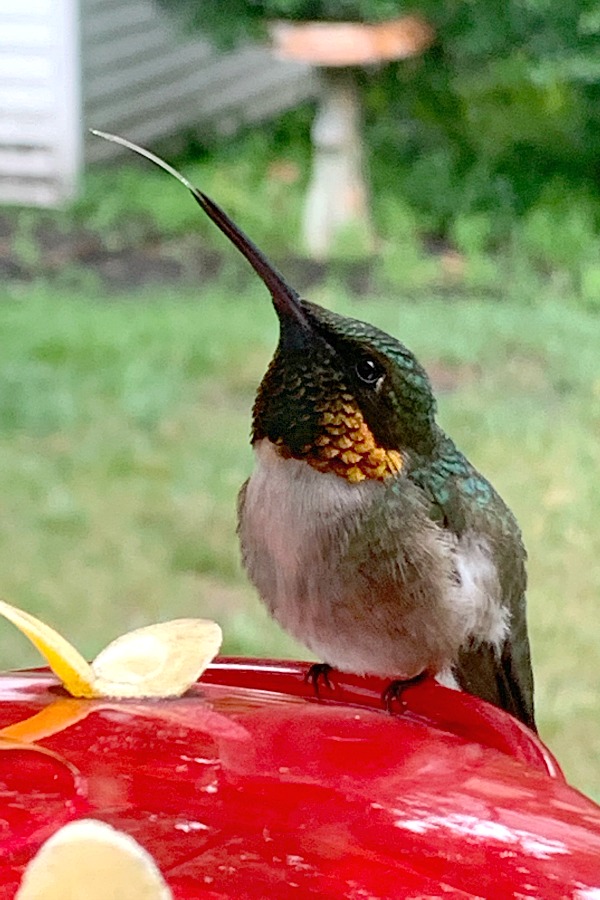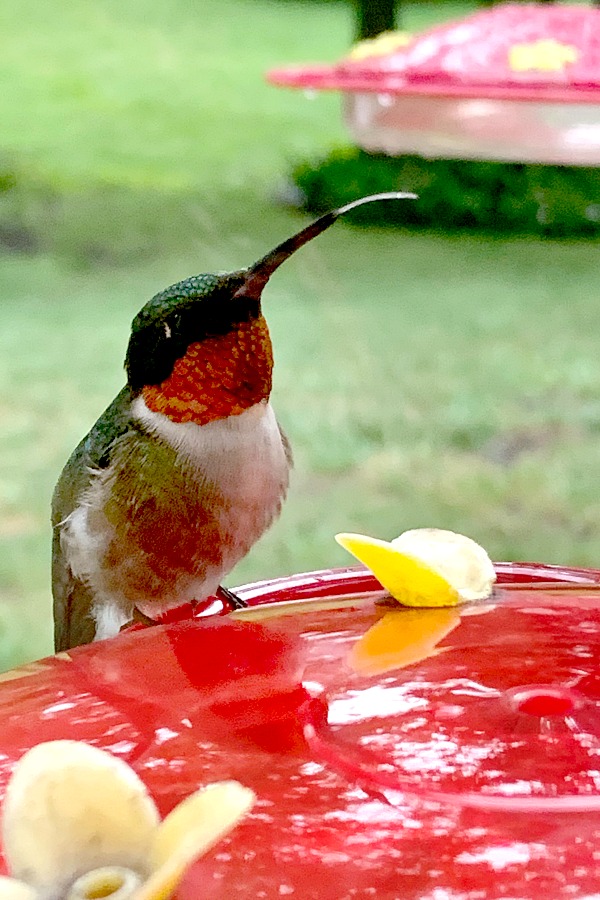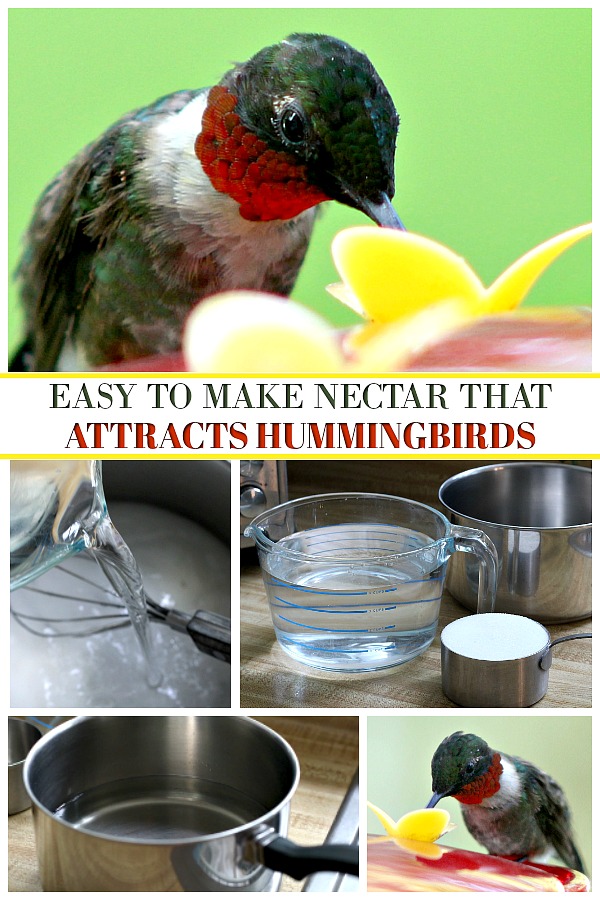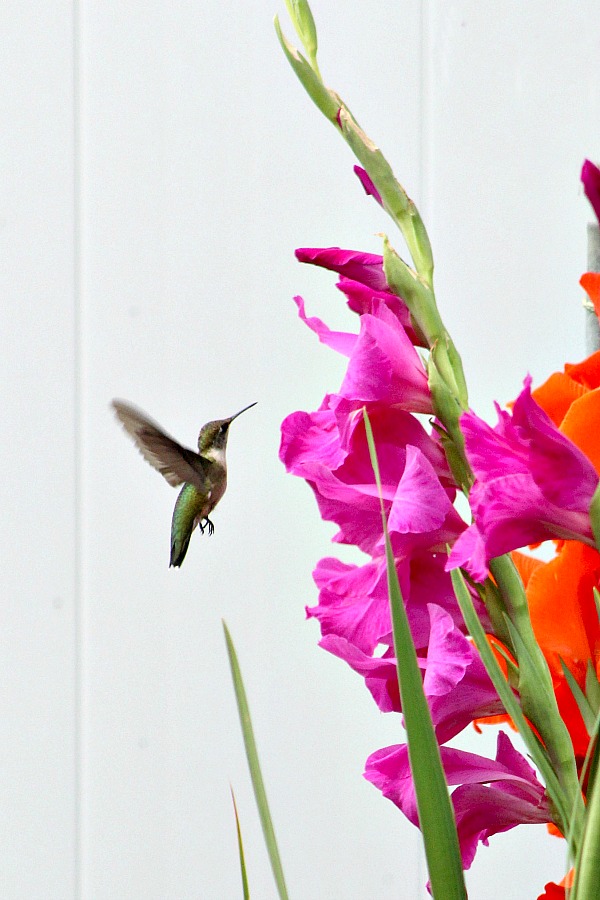 Did you know hummingbirds are the smallest of birds measuring from just under three inches to a little over 5-inches? Yet these petite birds are most fascinating and so exciting to watch as they flit to and fro each summer. One recent rainy day, a tiny hummingbird perched right outside my kitchen window for most of the morning allowing me to get this amazing video.
Did you know hummingbirds are the smallest of birds measuring from just under three inches to a little over 5-inches? Yet these petite birds are most fascinating and so exciting to watch as they flit to and fro each summer. One recent rainy day, a tiny hummingbird perched right outside my kitchen window for most of the morning allowing me to get this amazing video.
There are affiliate links in this post.
 Through the many years of attracting hummingbirds to our yard with flowers and providing feeders filled with homemade nectar, we have seen countless birds visit each summer. I have photographed them in flight, perched on a branch in a nearby tree and at the feeders.
Through the many years of attracting hummingbirds to our yard with flowers and providing feeders filled with homemade nectar, we have seen countless birds visit each summer. I have photographed them in flight, perched on a branch in a nearby tree and at the feeders.
Hummingbirds are fascinating
Male or female
Notice the brightly colored neck of the hummingbird in the above photos. Those brilliant throat feathers are called its “gorget” (pronounced gor-jit). When hit with sunlight, the gorget will glisten due to refraction, or the bending of sunlight against the different-sized feathers. Males can make the gorget appear to be black to avoid attracting predators.
Unlike males, the female hummingbirds do not have bright feathers to display. Females are often brown or dull green in color.
Ruby–throated hummingbirds
The most common hummingbird east of the Mississippi River is the ruby-throated hummingbird as seen in these photos. They live in woodland areas, but also frequent gardens where flowering plants are plentiful. These tiny birds are omnivores, sometimes feeding on insects and spiders including mosquitoes, gnats, fruit flies, and small bees. They eat insects and insect eggs on the ground and in trees and use their bill and not their tongue to catch them.
Hummingbirds generally spends the winter in Central America, Mexico, and Florida, and migrate to Eastern North America for the summer to breed. Some Ruby-throats migrate 600 miles across the Gulf of Mexico.
How hummingbirds fly
Hummingbirds can beat their wings more than 50 times a second and fly in an acrobatic style. They hover and also fly upside down and backwards and have extremely short legs, so they cannot walk or even hop with any efficiency.
Hummingbird diet
An adult ruby-throated hummingbird can eat twice its body weight in food each day, which it burns up with the high metabolism necessary to sustain its rapid wing beat and energetic movements.
These birds prefer to feed on the nectar of red or orange tubular flowers such as trumpet creeper, cardinal flower, honeysuckle, jewelweed, bee-balm, red buckeye and red morning glory. They also visit hummingbird feeders. We keep three feeders filled with fresh sugar-water bring many birds within viewing distance.
Returning Hummingbirds
Ruby-throated hummingbirds live about 3 to 4 years and some have been known to live as long as 9 years. And, amazingly, professional banders have observed many actually return to the same feeders year after year.
Try Amazon Prime 30-Day Free Trial
Tiny Hummingbird
 In all of the years we have had hummingbirds visit our feeders and the flowers planted in the yard just for them, I have never observed a bird behaving as this little fellow in these photos and the videos below. He flew to the feeder attached directly to the window and perched there for long periods of time, occasionally taking a drink. His body seemed to be “bouncing”. He flew off every so often and then returned after a few minutes with his head facing upward and his tongue extended.
In all of the years we have had hummingbirds visit our feeders and the flowers planted in the yard just for them, I have never observed a bird behaving as this little fellow in these photos and the videos below. He flew to the feeder attached directly to the window and perched there for long periods of time, occasionally taking a drink. His body seemed to be “bouncing”. He flew off every so often and then returned after a few minutes with his head facing upward and his tongue extended.
It was a day full of rain but I am not sure that was the reason for his unusual behavior. Out of concern, I called our local animal rescue to see what they thought. I was told as long as the hummingbird was drinking and able to fly without problem, that he was okay.
The hummingbird stayed all through the morning into the early afternoon when the rain stopped and the sky brightened. He returned again a dusk as all of the hummers do and I saw him briefly the following day.
I haven’t seen this specific hummingbird back at the feeder since and hope he fared well. Please drop me a comment or email if you have you had a similar situation with birds at your feeders.
You might also like…
Make Your Own Hummingbird Nectar
 Our Newsletter is published once every three weeks. Each issue is timely and helpful, jam-packed with food, crafts, occasional DIY, gardening and faith resources. Relevant and seasonal posts to inspire and guide you with current trends. Available only to those who request it, so please accept our invitation to stay connected and join the Grateful Prayer Thankful Heart community. Just click the subscribe button below.
Our Newsletter is published once every three weeks. Each issue is timely and helpful, jam-packed with food, crafts, occasional DIY, gardening and faith resources. Relevant and seasonal posts to inspire and guide you with current trends. Available only to those who request it, so please accept our invitation to stay connected and join the Grateful Prayer Thankful Heart community. Just click the subscribe button below.


Lorraine I had the exact same experience with a hummer a few weeks ago he/she appeared to be a little larger than most hummers (chubbier) than its counterparts and acted the same way! He/she appeared to be a little distressed and I too worried about the little one and thought about him all the next day. He stayed for at least a 1/2 hour occasionally dipping his tongue in for a drink. Now I wonder??
Hi Kimberly,
Thank you for stopping by and sharing your experience with a hummer at your feeder. Sounds just the same including the observation that your hummer was chubbier that the usual visitors to the feeder. In all of the years we have had these beautiful little birds in our yard, we never had one exhibit this behavior.
Hope you enjoy the rest of the summer!
Kindly, Lorraine
I don’t see where the video is — how am I missing it?
Sue,
There add 2 videos in the post. They are after the Amazon product ads and before the title ‘Hummingbirds an gladiolus’. Hope you find them!
Sincerely, John
Sue,
After further investing I found that our grandson didn’t have the videos either on his computer but informed us that he had an ad blocker activated. Once he disabled that, the videos appeared. Check to see if you have an ad blocker activated on your browser, if so you can disable it or put our sites’ URL (https://gratefulprayerthankfulheart.com) on the whitelist.
Thanks for your support, John
Amazing! We have several now attracted to a flowering plant by our kitchen window. I always wonder why the female birds are the dowdy ones. You’ve learned a lot about these tiny birds.
How wonderful that he stayed so long to allow you to get photos and video. I’ve never had luck with attracting them and when I have seen them they were far to quick for me to get pictures.